
- Android手机获取root权限并实现关机重启功能的方法
- Android中修改设备权限的方法
- Android应用开发工程目录作用介绍
- ScrollView滚动条颜色的设置方法
- Android 组件Gallery和GridView示例讲解
- Android开发:TextView加入滚动条示例
- Android开发从相机或相册获取图片裁剪
- Android显示网络图片实例
- Android应用中内嵌SQLite数据库的基本操作指南
- android RadioButton和CheckBox组件的使用方法
- Android获取手机配置信息具体实现代码
- Android 听筒模式的具体实现实例
- android平台HttpGet、HttpPost请求实例
- android自定义RadioGroup可以添加多种布局的实现方法
- Android实现类似360,QQ管家那样的悬浮窗
- Android Metro菜单实现思路及代码
- android多行标签热点示例
- Android listview动态加载列表项实现代码
- Android编程之书架效果背景图处理方法
- Android客户端软件开发_16、下载模块的下载实现,Hnadler在不同线程之间的通信
- android使用PopupWindow实现页面点击顶部弹出下拉菜单
- Android App在线程中创建handler的方法讲解
- Android下拉刷新官方版
- Android编程实现在Bitmap上涂鸦效果
- Android提高之TelephonyManager功能探秘
- 2013年 移动App设计13项注意细节总结
- 完美解决EditText和ScrollView的滚动冲突(上)
- Android 模拟信号示波器示例代码
- 超好看的下拉刷新动画Android代码实现
- Android中通过RxJava进行响应式程序设计的入门指南
Android仿QQ好友列表实现列表收缩与展开
ExpandableListView是一个垂直滚动显示两级列表项的视图,与ListView不同的是,它可以有两层:每一层都能够被独立的展开并显示其子项。
好友QQ列表,可以展开,可以收起,在android中,以往用的比较多的是listview,虽然可以实现列表的展示,但在某些情况下,我们还是希望用到可以分组并实现收缩的列表,那就要用到android的ExpandableListView,今天研究了一下这个的用法,也参考了很多资料动手写了一个小demo,实现了基本的功能,下面直接上效果图以及源代码~!
本文效果:
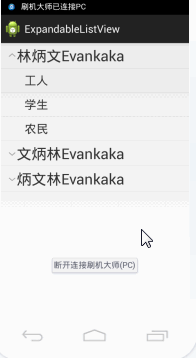
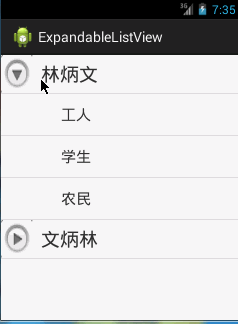
一、实现原理
1、首先必须在布局文件中定义一个ExpandableListView
2、其次创建一级条目对应的布局文件group
3、创建二级条目对应的布局文件child
4、加载ExpandableListView组件的Activity必须继承自ExpandableListActivity
二、布局与代码
1、首先在主布局中activity_main.xml
<LinearLayout xmlns:android="http://schemas.android.com/apk/res/android"
android:layout_width="fill_parent"
android:layout_height="fill_parent"
android:orientation="vertical" >
<ExpandableListView
android:id="@id/android:list"
android:layout_width="fill_parent"
android:layout_height="fill_parent" />
</LinearLayout>
2、其次在drawable文件夹定义布局一级列表groups.xml
<LinearLayout
xmlns:android="http://schemas.android.com/apk/res/android"
android:orientation="vertical"
android:layout_width="fill_parent"
android:layout_height="fill_parent"
>
<TextView
android:id="@+id/textGroup"
android:layout_width="fill_parent"
android:layout_height="fill_parent"
android:paddingLeft="40px"
android:paddingTop="6px"
android:paddingBottom="6px"
android:textSize="25sp"
android:text="No data"
/>
</LinearLayout>
3、接着在drawable文件夹定义布局二级列表childs.xml
<LinearLayout
xmlns:android="http://schemas.android.com/apk/res/android"
android:orientation="vertical"
android:layout_width="fill_parent"
android:layout_height="fill_parent"
>
<TextView
android:id="@+id/textChild"
android:layout_width="fill_parent"
android:layout_height="fill_parent"
android:paddingLeft="60px"
android:paddingTop="10px"
android:paddingBottom="10px"
android:textSize="20sp"
android:text="No Data"
/>
</LinearLayout>
4、然后就是初始化和使用了
package com.example.expandablelistview;
import java.util.ArrayList;
import java.util.HashMap;
import java.util.List;
import java.util.Map;
import android.os.Bundle;
import android.app.ExpandableListActivity;
import android.util.DisplayMetrics;
import android.view.View;
import android.widget.ExpandableListView;
import android.widget.SimpleExpandableListAdapter;
import android.widget.Toast;
public class MainActivity extends ExpandableListActivity {
/**
* 创建一级条目容器
*/
List<Map<String, String>> gruops = new ArrayList<Map<String, String>>();
/**
* 存放内容, 以便显示在列表中
*/
List<List<Map<String, String>>> childs = new ArrayList<List<Map<String, String>>>();
@Override
public void onCreate(Bundle savedInstanceState) {
super.onCreate(savedInstanceState);
setContentView(R.layout.activity_main);
setListData();
}
/**
* 设置列表内容
*/
public void setListData() {
// 创建二个一级条目标题
Map<String, String> title_1 = new HashMap<String, String>();
Map<String, String> title_2 = new HashMap<String, String>();
Map<String, String> title_3 = new HashMap<String, String>();
title_1.put("group", "林炳文");
title_2.put("group", "文炳林");
gruops.add(title_1);
gruops.add(title_2);
// 创建二级条目内容
// 内容一
Map<String, String> title_1_content_1 = new HashMap<String, String>();
Map<String, String> title_1_content_2 = new HashMap<String, String>();
Map<String, String> title_1_content_3 = new HashMap<String, String>();
title_1_content_1.put("child", "工人");
title_1_content_2.put("child", "学生");
title_1_content_3.put("child", "农民");
List<Map<String, String>> childs_1 = new ArrayList<Map<String, String>>();
childs_1.add(title_1_content_1);
childs_1.add(title_1_content_2);
childs_1.add(title_1_content_3);
// 内容二
Map<String, String> title_2_content_1 = new HashMap<String, String>();
Map<String, String> title_2_content_2 = new HashMap<String, String>();
Map<String, String> title_2_content_3 = new HashMap<String, String>();
title_2_content_1.put("child", "猩猩");
title_2_content_2.put("child", "老虎");
title_2_content_3.put("child", "狮子");
List<Map<String, String>> childs_2 = new ArrayList<Map<String, String>>();
childs_2.add(title_2_content_1);
childs_2.add(title_2_content_2);
childs_2.add(title_2_content_3);
childs.add(childs_1);
childs.add(childs_2);
/**
* 创建ExpandableList的Adapter容器 参数: 1.上下文 2.一级集合 3.一级样式文件 4. 一级条目键值
* 5.一级显示控件名 6. 二级集合 7. 二级样式 8.二级条目键值 9.二级显示控件名
*
*/
SimpleExpandableListAdapter sela = new SimpleExpandableListAdapter(
this, gruops, R.drawable.groups, new String[] { "group" },
new int[] { R.id.textGroup }, childs, R.drawable.childs,
new String[] { "child" }, new int[] { R.id.textChild });
// 加入列表
setListAdapter(sela);
}
/**
* 列表内容按下
*/
@Override
public boolean onChildClick(ExpandableListView parent, View v,
int groupPosition, int childPosition, long id) {
Toast.makeText(
MainActivity.this,
"您选择了"
+ gruops.get(groupPosition).toString()
+ "子编号"
+ childs.get(groupPosition).get(childPosition)
.toString(), Toast.LENGTH_SHORT).show();
return super.onChildClick(parent, v, groupPosition, childPosition, id);
}
/**
* 二级标题按下
*/
@Override
public boolean setSelectedChild(int groupPosition, int childPosition,
boolean shouldExpandGroup) {
return super.setSelectedChild(groupPosition, childPosition,
shouldExpandGroup);
}
/**
* 一级标题按下
*/
@Override
public void setSelectedGroup(int groupPosition) {
super.setSelectedGroup(groupPosition);
}
}
5、效果
这是我手机上的效果,点击工人。学生等二级列表时,我手机上会有提示框出现的,但是不知为什么录制下来就是没有。
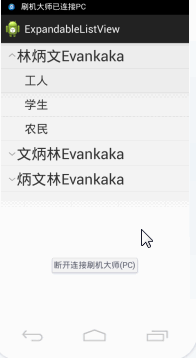
三、自定义列表图标
上面的图标是系统自己生成的,下面我们要改成自己的
1、更改自定义图标
在drawable文件夹下新建expandablelistview_change.xml
<?xml version = "1.0" encoding = "utf-8"?> <selector xmlns:android = "http://schemas.android.com/apk/res/android" > <item android:state_expanded = "true" android:drawable = "@drawable/w2"/> <item android:drawable = "@drawable/w1"/> </selector >
2、修改上面布局Activity.main.xml
<LinearLayout xmlns:android="http://schemas.android.com/apk/res/android"
android:layout_width="fill_parent"
android:layout_height="fill_parent"
android:orientation="vertical" >
<ExpandableListView
android:id="@id/android:list"
android:layout_width="fill_parent"
android:layout_height="fill_parent"
android:background="#f5f5f5"
android:cacheColorHint="#f5f5f5"
android:groupIndicator="@drawable/expandablelistview_change" />
</LinearLayout>
其实就是加了一句
android:groupIndicator="@drawable/expandablelistview_change"
下面我们再来看看效果:
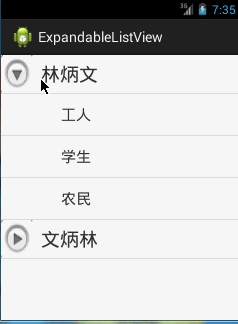
四、图标放置右边
在上面MainActivity.java的函数setListData()加中:
// 得到屏幕的大小 DisplayMetrics dm = new DisplayMetrics(); getWindowManager().getDefaultDisplay().getMetrics(dm); //图标设置在右边 getExpandableListView().setIndicatorBounds(dm.widthPixels-60, dm.widthPixels); // 设置指示图标的位置
效果:
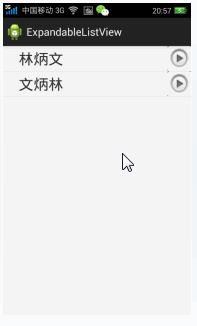
以上就是本文的全部内容,希望对大家的学习Android软件编程有所帮助。
- 上一篇文章: Android布局之TableLayout表格布局
- 下一篇文章: Android布局之RelativeLayout相对布局
- android Setting中隐藏项实现原理与代码
- ListView的Adapter使用(绑定数据) 之 自定义
- Android编程之ListPreference用法实例分析
- Android之用PopupWindow实现弹出菜单的方法
- Android实现树形层级ListView
- Android组件之DrawerLayout实现抽屉菜单
- Android编程之九宫格实现方法实例分析